3660Pavel
There is an opinion among many people that cats do not get sick. However, these cute pets can suffer from a variety of diseases. It’s just that the symptoms of the disease in an animal do not appear as quickly as in people. Bronchial asthma in a cat is not such a rare phenomenon. The chronic condition of the respiratory system is accompanied by constant attacks of difficult breathing. The provocateurs of the disease are asthmatic pathogens. Penetrating into the animal's body, they provoke the development of an allergic reaction. The cat’s immune system reacts to pathogenic processes by producing histamine, which has a painful effect on the bronchioles, inflaming them and narrowing the lumen. Symptoms and treatment of asthma in cats are the prerogative of a veterinarian.
The course of the disease may be aggravated by muscle spasms. Swelling of the epithelium also occurs, and a lot of mucus appears.
© shutterstock
Features of the disease
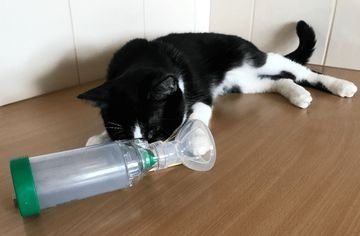
Domestic cats can suffer from “human” diseases, one of which is bronchial asthma.
Description
With this disease, during the inflammatory process, muscle spasm occurs, the bronchi narrow, their walls swell, and the animal begins to choke.
The disease is chronic and cannot be completely cured.
Symptoms
Signs appear depending on the stage of the disease. The owner can observe them daily or 1-2 times a week.
Symptoms of asthma in cats:

restless behavior (the animal rushes from corner to corner);- attack of suffocation;
- wheezing and whistling are heard during breathing;
- a crisis happens unexpectedly and can catch a cat anywhere.
What to pay attention to: during attacks, the animal takes a characteristic position on half-bent legs, the head is lowered to the floor, the mouth is open, breathing is heavy and rapid. After an attack, the cat is lethargic and apathetic.
Signs of asthma in cats
The symptoms of feline asthma are exactly the same as those of humans, and the first few attacks can be quite frightening. Asthma is spasm of the bronchi and shortness of breath when exhaling. The cat becomes quiet and intermittently and loudly tries to inhale and exhale, although some animals rush around in panic, trying to inhale.
The animal also takes a hunched position with its neck stretched down, and a whistle is heard when breathing. During quiet periods, the cat exhibits unusually low activity and breathes frequently.
We recommend calling a veterinary ambulance in case of asthmatic attacks, because the symptoms of the disease are similar to a heart attack or pulmonary failure. Asthma is dangerous due to oxygen deprivation, which is manifested by blue mucous membranes.
When can the disease develop?
Allergies are one of the common causes of asthma in cats . A negative reaction of the body manifests itself after inhaling tobacco smoke, pollen, household chemical vapors, dust, and mold.
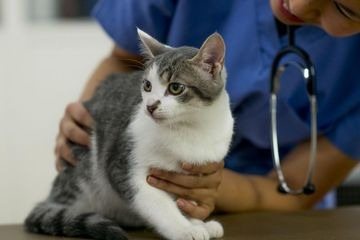
The development of asthma is not affected by the gender and age of the animal.
The disease is more common in Persian, Burmese and Siamese cats, although veterinarians believe that breed does not affect the incidence of the pathology.
The disease can be inherited. Other causes of suffocation in cats are respiratory tract infections, stress, and autoimmune diseases.
Danger to humans
It is believed that cats are additional irritants for asthmatics. The opposite situation is also possible in the house: when the asthmatic is the cat itself.
Bronchial asthma has no direct danger to humans. This disease is not transmitted as an infection. The negative impact on humans of asthma in a cat manifests itself as follows:
- it is difficult for the pet owner to observe seizures, especially if they are severe and convulsive;
- the owner’s serious experiences can have a negative impact on the psyche, especially when it comes to a child.
Important! For adults, sedatives may be used. It is necessary to conduct a preventative conversation for the child to calm him down.
Diagnosis of pathology
Only a veterinarian can make an accurate diagnosis.
To do this, the owner of the animal must accurately and in detail describe all the symptoms of the disease. The necessary tests are prescribed.
How to distinguish it from other diseases
During the diagnostic process, the following diseases may be suspected: mycoplasmosis, pathologies of the heart muscle, pneumonia, viral rhinotracheitis, bordetellosis, oncological neoplasms, foreign body entry into the bronchi.

The symptoms of an attack of pathology are similar to regurgitation of a hairball or a situation where a cat choked on a bone.
But feline asthma has a number of characteristic features: frequency, good general health, excellent appetite. Basically, the animal feels satisfactory, but on certain days it experiences attacks of suffocation. They are repeated periodically.
Examination at the initial stage of the disease
It is worth visiting the veterinarian on the same day that the attack occurs. The doctor will examine the animal and listen to the lungs with a stethoscope. Depending on the general condition, tests and examinations are prescribed.
First of all, the animal must be dewormed. This is due to the fact that some types of helminths live in the lungs of animals, destroying the integrity of the organ, making breathing difficult.
X-ray of the lungs
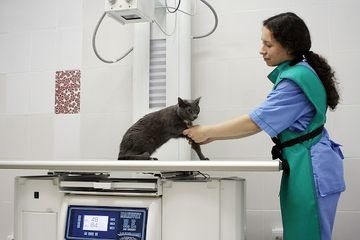
The most effective examination is a chest x-ray. The procedure allows us to detect thickening of the walls of the bronchi and stretching of the diaphragm. These are the main indicators of the disease.
Also, with the help of the study, heart pathologies, pneumonia, oncology, and the presence of foreign bodies are excluded.
Bronchoalveolar lavage
During the procedure, a special sterile solution is injected into the animal's lungs. Subsequently, it is removed, and the resulting sample is examined for its cellular composition. A bronchoscope is used in the process.
The tool helps the doctor assess the condition of the cat’s respiratory tract and take tissue from the most damaged areas for analysis.

Bronchoalveolar lavage also has a therapeutic function. After the procedure, the animal’s airways expand, and the pet’s condition improves significantly.
Diagnostics: examination, x-ray and bronchoscopy
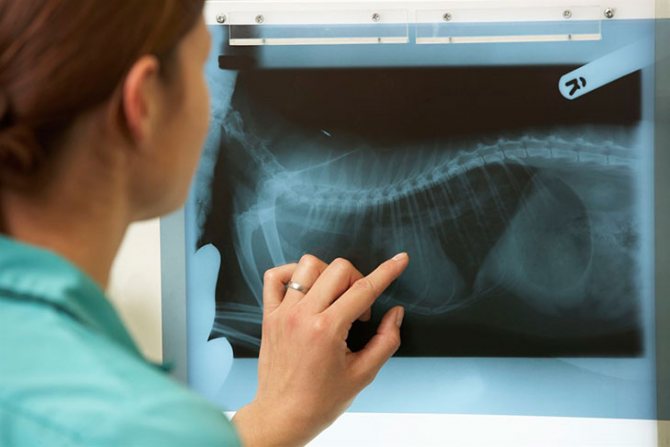
At an appointment at a veterinary clinic, the cat will have a general blood test to determine the number of eosinophils, will be examined (determining the condition of the fur, skin, measuring body temperature) and will listen to the sternum area using a phonendoscope for the presence of wheezing. Be prepared for questions about the pet’s life, the conditions of its maintenance and nutrition.
One of the methods for diagnosing asthma in a cat is radiography, which is a method of dynamic research using x-rays. In real time, using this device, the veterinarian is able to monitor the condition of the animal’s internal organs and select the most suitable projection for the image in order to determine the presence or absence of inflammatory processes in the lungs.
In cases where the results of radiographic examination are in doubt, veterinary medicine resorts to bronchoscopy. This is the introduction of a thin bronchoscope into the trachea and bronchi for direct examination and a more detailed examination of their condition. This type of diagnosis can also be used to perform a biopsy for the purpose of further histological examination or to remove foreign bodies.
Treatment: remedies and prognosis
It is known that it is impossible to determine with 100% accuracy the allergen that provokes asthma. Because of this, the disease is considered incurable. But it is quite possible to control the frequency of attacks and learn to stop them as quickly as possible.
With proper therapy, you can achieve long-term and stable remission without recurring crises.
Drugs
Asthma is a chronic condition that can be relieved by glucocorticoids. Extended-release drugs (Dexafort) are easy to use.

To relieve inflammation in the lungs, tablets are prescribed for regular use, for example, Prednisolone.
Medicines that dilate the bronchi (Salbutamol) are also indicated.
Glucocorticosteroids have a significant drawback: with their long-term administration, diabetes mellitus, kidney failure, and liver problems can begin.
The dosage and duration of taking medications is prescribed only by a veterinarian after an examination.
Spacers
An effective treatment for asthma is inhalation through a special mask. The procedure is recommended even for kittens. The animal inhales the necessary medicine, which stops the attack.
Spacers designed for use in animals are now available.
Antibiotics

Antibiotics may be used to treat asthma in cats. They are effective if asthma attacks are of an infectious nature or a secondary infection has developed during the course of the disease.
What to do at home
Basic rules of first aid for animals:
- the best popular advice is to recommend that the owner himself calm down;
- make sure that the cat does not hurt itself;
- eliminate possible dangers for her in space;
- during an attack, you should not grab the animal;
- after the seizures stop, move the animal to a box, a safe place, or take it to a doctor;
- Monitor the symptoms of attacks so that you can later tell them to the veterinarian for an accurate diagnosis.
In case of a prolonged and severe attack, you should:
- actions must be quick and decisive;
- urgently take the animal to the veterinarian;
- if it is not possible to get to the clinic in the near future, you should consult a doctor by phone during the attack;
- You can call a specialist to your home, if possible;
- use the required drug if it has already been prescribed and purchased in advance.
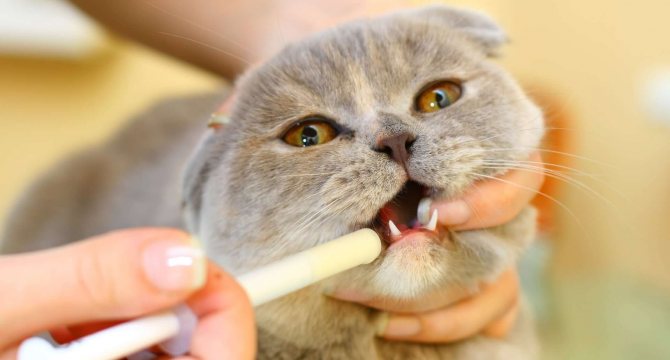
To treat asthma at home, it is better to consult a doctor
Caring for a sick animal
An asthmatic cat should live in a clean room, avoiding contact with chemicals, dust, and tobacco smoke. Wet cleaning is done daily; the use of household chemicals is unacceptable. You can get an air purifier and humidifier.
The cat is bathed as needed. Use only hypoallergenic cosmetics.
Regular treatment against parasites is important: helminths, fleas, lice eaters, ticks.
In spring and summer, during periods of flowering plants, it is recommended not to open windows. If you have to ventilate the room, hang a damp cloth or gauze in the opening: it will trap flying pollen.

The cat's diet should be balanced. Chicken, corn, milk, seafood, and rare varieties of fish are excluded from the diet, because these products contain allergens.
It is recommended to switch to ready-made hypoallergenic food. To maintain immunity, vitamin supplements and complexes are prescribed.
Cat Breeds for Asthmatics
Cats are considered more anti-allergenic than dogs. Asthma does not appear as often in cats. It is important to note that it is better to have a cat rather than a male cat. After all, it is known that males mark territory. This means they release substances that are harmful to allergy sufferers. You can get rid of such a misunderstanding only by castrating your pet.
So which cats are harmless for allergy sufferers and asthmatics? These are the following breeds:
Canadian and Don Sphynxes
He tops the rating of cats for asthmatics. This hairless pet is able to live safely even with the most severe allergies. Do not forget about the secretion of skin secretions and periodically bathe the animal.
Cornish Rex
The fur of these cats is soft. Rarely falls out and has few allergens.
Javanese cat or Javanese
A beautiful cat with long ears. Hair without undercoat.
Balinese cat
Despite the long hair, it is not dangerous for asthmatics.
Siberian cat
The fluffiest of the hypoallergenic ones.
Devon Rex
Very short curly fur. You won't find hairs from this cat on furniture or carpets.
Oriental cat Minimal hair.
Preventing asthma
The owner of a cat, who has observed how suffocation manifests itself in a pet at least once in his life, will never want the situation to repeat itself. To prevent asthmatic attacks, a number of rules have been developed that should be followed if your pet suffers from allergies.
Healthy activity is important for the animal's immunity. The pet is given at least an hour a day and outdoor games are organized with it.
In the room where the cat lives, it is better to remove all flowering indoor plants. It is also recommended to avoid carpeting, because... dust accumulates in them.
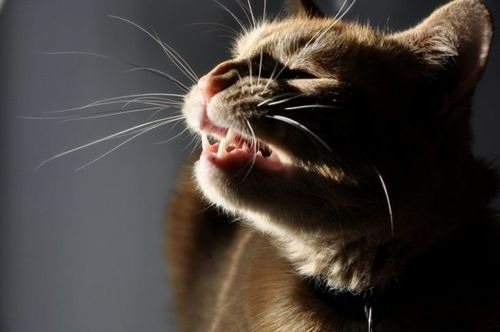
Important! Smoking is prohibited in the room where the cat lives. Sooner or later, this bad habit will affect your pet’s health. Tobacco smoke is especially dangerous for animals with allergies or asthma.
You cannot feed the animal from the owner's table. Smoked products, flavor enhancers, seasonings, and sweets can cause choking.
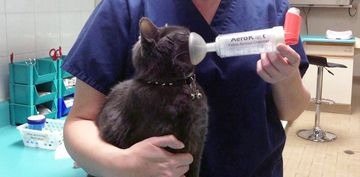
If the source of the allergens is known, it is necessary to eliminate it or minimize the pet’s contact with it.
It is important to protect your cat from stressful situations: do not light sparklers, do not use firecrackers on holidays, and explain to children how to handle the animal.
Regular (at least once every six months) examinations by a veterinarian are important. A doctor can identify the first signs of a dangerous disease at an early stage.










